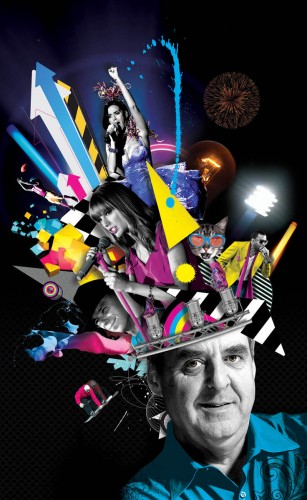
Illustration by Matt Herring
Walk into Lightborne’s office on East 14th Street and you immediately notice evidence of the creative class at work—a small army of bikes neatly parked just inside the door; the concrete expanse of a converted industrial building with floor-to-ceiling windows; and bright, delicate fangs of white lights dangling from the ceiling. The space itself sends a message: Artistic pursuits happen here.
The local design and production company’s oeuvre ranges from video content for sold-out arena concerts to regional TV commercials, the extravagant to the sublimely simple. There’s the haunting luminosity of naked lightbulbs slowly bending in time behind Jay Z on stage, but there’s also Scooter the Neutered Cat ads and the schmaltzy silliness of Ohio for Responsible Gambling’s “I Lost a Bet” campaign. It’s as big as Katy Perry’s undulating checkerboard during her Super Bowl halftime show and as local as Gold Star Chili.
Lightborne’s office may embody the hispster-esque atmosphere of its surrounding Over-the-Rhine milieu and boast an impressive roster of clients—including Kanye West, Billy Joel, Fleetwood Mac, American Idol, and Taylor Swift—but the company has deep roots in the city. It was founded 30 years ago and in 1997 took advantage of tax credits to move into its current building between Sycamore and Main, making it “ahead of the curve of OTR,” according to Lightborne’s president Scott Durban.
Durban is a card-carrying local. He attended La Salle High School, the Art Academy, and the University of Cincinnati before working on-location for films such as Eight Men Out and City of Hope. He later moved to Miami to run his own production company, filming commercials all over the world for Heineken, Audi, and Burger King and shooting music videos with Lightborne’s then-creative director Ben Nicholson. When Durban moved back to Cincinnati in 2005, he quickly joined Lightborne as an executive producer. By 2008, he was president and COO.
A Collection of Lightborne’s Work
Today, Lightborne employs a creative bullpen of 30 designers, editors, and producers; for bigger gigs they will bring in 50 to 60 additional freelancers to do grip, electric, hair, and makeup. Permanent team members work in crisp offices warmed by the glow of a couple computer monitors apiece while creative directors splice together shots to fill the Jumbotrons during Kenny Chesney’s next tour. Chesney was the first major artist to hire Lightborne for tour design—in-concert video, graphics, lighting, and other visuals—almost a decade ago, back when most of the company’s work consisted of commercials and long-form branding videos. Over time, through relationships and reputation, the client list of musicians grew. It’s a heavily hands-on process that accounts for roughly 85 percent of Lightborne’s artistic work, including hours of back-and-forth between creative directors and producers followed by onsite work where the team sits with its artists during rehearsal, taking notes and making adjustments.
“We’ve been tempted to open a West Coast office, because that’s where most of the entertainment comes from,” says Durban, though he admits it would still be just a satellite shop. Even pop stars have budget constraints, and the lower overhead cost in Cincinnati “helps us do work that maybe couldn’t be done in Los Angeles because of the price point.”
It also offers peak creative opportunities for local artists. Ryan McAllister was a senior designer for the Super Bowl halftime performance. A bearded 30-year-old with sincere eyes outlined in thick, black frames, he could be the poster child for OTR. “People are starting to realize, especially with technology, you don’t have to live on one of the coasts in order to participate in this global creative realm,” he says.
“Somebody like Ryan, 10 years ago he would have had to go to New York or L.A. to do the level of work he’s doing right now,” Dan Bryant, Lightborne’s new executive producer and a recent Chicago transplant, chimes in.
The fact that a company like Lightborne is able to operate—and more important, remain—in Cincinnati has allowed the city to develop and foster pockets of independent creative businesses in places like OTR. “Look at where we are right now,” says Bryant. He’s referring to the neighborhood, but the same could be said of the building he’s standing in—a local firm shining the brightest lights on the biggest stages.
Originally published in the May 2015 issue.










Facebook Comments